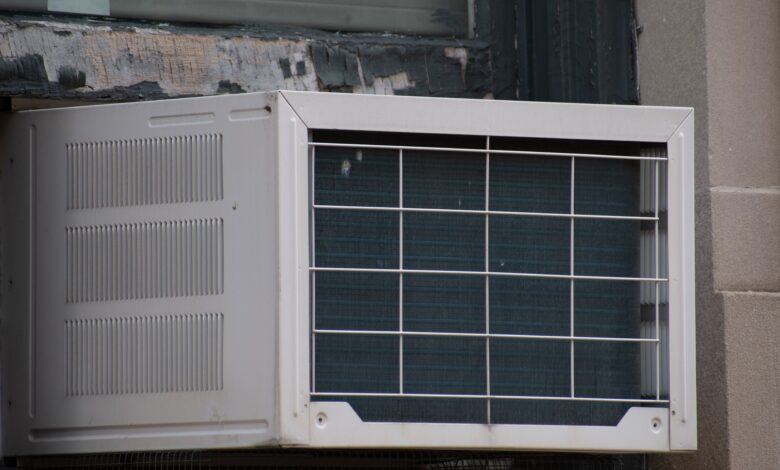Working principle of window Air conditioners

Is your home feeling a bit uncomfortable this summer? If so, you might be curious about how window air conditioners operate and whether a window unit could be the right solution for your home. Let’s explore the workings of a window AC unit and see if it’s something you can benefit from this summer.”
What is Window Air Conditioner?
A window air conditioner represents the most basic form of AC unit. This compact, all-in-one device houses all necessary parts and components within a single box or casing. Typically, it is installed in a window and connects to a standard electrical outlet. Its convenience lies in its portability, allowing it to be relocated from one window to another as needed, and it functions independently of a home’s HVAC system.
How does a window unit work?
A window air conditioner functions using the same principles as other air conditioning systems. It employs refrigeration properties to extract heat and humidity from a room while circulating cool air back into the space. The essential components of a window AC unit include a thermostat, a fan or blower, tubing filled with refrigerant, a compressor, an evaporator coil, and a condenser coil.
When the room temperature rises, the thermostat in the AC unit is activated, which turns on the blower. The unit draws in room air and moves it over the cold refrigerant coils. As the air passes over these cold coils, it is cooled and then pushed back out into the room, lowering the room’s temperature and making it more comfortable.
The Refrigeration Cycle: The Heart of Cooling
At the core of a window air conditioner is the refrigeration cycle, a process that moves heat from one place to another using a refrigerant, a special fluid with excellent heat-absorbing and heat-releasing properties. The refrigeration cycle comprises four main stages: compression, condensation, expansion, and evaporation.
- Compression: The cycle begins with the compressor, a pump located inside the unit. The compressor compresses the refrigerant gas, raising its temperature and pressure. This high-pressure, high-temperature gas then flows into the condenser coil.
- Condensation: In the condenser coil, which is located at the back of the unit, the hot refrigerant gas releases its heat to the outside air. A fan helps to dissipate this heat, causing the refrigerant to cool and condense into a high-pressure liquid. This is why you’ll often feel warm air blowing from the back of an air conditioner.
- Expansion: The now liquid refrigerant passes through an expansion valve or capillary tube, where it undergoes a rapid drop in pressure. This pressure drop causes the refrigerant to cool significantly as it enters the evaporator coil inside the unit.
- Evaporation: In the evaporator coil, the cold refrigerant absorbs heat from the indoor air. A fan blows warm room air over the evaporator coil, cooling the air before it is circulated back into the room. During this process, the refrigerant evaporates and turns back into a low-pressure gas, ready to be compressed again, completing the cycle.
The Role of Fans and Filters
Two fans are crucial in a window air conditioner’s operation: the blower fan and the exhaust fan. The blower fan pulls warm indoor air through the filter and across the evaporator coil, where the air is cooled and dehumidified. This cooled air is then blown back into the room, providing the cooling effect that we feel.
The exhaust fan, on the other hand, pulls outdoor air across the condenser coil, aiding in the heat dissipation process. This fan ensures that the heat absorbed from the indoor air is efficiently expelled outside.
Filters are another essential component. They trap dust, pollen, and other airborne particles, ensuring that the air circulated back into the room is clean. Regular maintenance of these filters is crucial for the efficient functioning of the air conditioner and for maintaining good indoor air quality.
Thermostat and Controls
Most window air conditioners come equipped with a thermostat, which helps regulate the temperature of the room. When the thermostat detects that the room has reached the desired temperature, it signals the compressor to stop. The fans may continue to run, but the cooling process halts until the room warms up again, triggering the compressor to resume cooling.
Modern window air conditioners often come with additional features like timers, remote controls, and energy-saving modes. These features offer convenience and help in managing energy consumption, making the unit more efficient and user-friendly.
A Symphony of Components
Window air conditioners are a marvel of engineering, combining principles of thermodynamics, fluid mechanics, and electronics to create a comfortable indoor environment. Despite their compact size, these units pack a powerful punch, capable of cooling rooms quickly and efficiently.
Understanding how a window air conditioner works not only demystifies the appliance but also highlights the importance of regular maintenance. Keeping the filters clean, ensuring proper installation, and conducting periodic checks can prolong the life of the unit and maintain its efficiency.
As technology advances, we can expect even more energy-efficient and environmentally friendly designs, continuing the evolution of this indispensable appliance. For now, however, the simple yet effective design of window air conditioners continues to provide respite from the sweltering heat, making our lives a bit more comfortable, one cool breeze at a time
Related Posts
| How AirPods Works? |




Hello, Jack speaking. I’ve bookmarked your site and make it a habit to check in daily. The information is top-notch, and I appreciate your efforts.